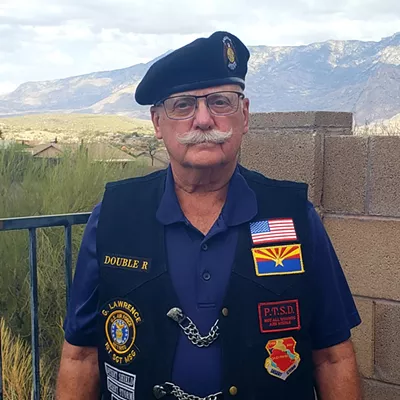As our great recession unfolded, Congress and the Obama administration hammered together the American Recovery and Reinvestment Act of 2009. Among programs created by this sweeping legislation was one funneling some $50 billion to the states through the U.S. Department of Education.
While the lion's share of that money was mandated for education, a percentage could be used at the discretion of governors for public safety and other essential services—and therein was the perfect recipe for politics.
So you probably wouldn't be surprised to learn that Arizona Gov. Jan Brewer aimed a large chunk of that discretionary funding toward border security, including a $10 million effort she called the Border Security Enhancement Program.
"The federal government has failed in its obligation and moral responsibility to secure our border," Gov. Brewer announced in April. "... With the resources we have today, I am doing everything within my power to ensure and promote safety for our citizens along our southern border."
For a leader who ultimately owed her re-election to tough border talk, the program could be considered a shrewd move. But according to critics, it also reflects misplaced priorities in a cash-strapped state—that is already awash in border law-enforcement resources.
"It's ironic that funds that were slated for fiscal stabilization were used to create this new program," says Tom Barry, director of the TransBorder Project with the Center for International Policy, based in Washington, D.C. "It seems like a misprioritization of funding, given the fiscal instability of the state; $10 million is a considerable amount of money that can be better spent on services that are endangered."
Known as the State Fiscal Stabilization Fund, or SFSF, the Education Department money came with several strings attached. For instance, governors had to commit the lion's share to reforming their states' educational systems, a directive that included everything from beefing up student-achievement assessments and improving low-performing schools to boosting the effectiveness of teachers. Primarily, the money was meant to "backfill" education budgets and protect such efforts in the midst of a funding crisis.
At the same time, $10 million in SFSF discretionary funds were divided among police and fire departments throughout the state. Another $10 million then bankrolled the Border Security Enhancement Program—a move that Barry says violates at least the spirit of those Education Department allocations. "The main focus (of the funding) was to keep education systems alive during times of economic downturn, when states were having fiscal problems."
Instead, he says Gov. Brewer used the money to curry political favor. "It showed her devotion to border security. But I don't think anybody thinks it's going to make any difference" along the Mexican line.
However, Brewer spokesman Paul Senseman argues that the spending was clearly justified. He points out that the vast majority of SFSF funding—$832 million—went to education, while the remaining $185 million was to be used as the governor wished. Nor was that discretionary spending done in the dark, he says.
"As part of the application process with the feds, you are to reveal the subject matter those (funds) would apply to. Last year in the application, the governor announced that some would be utilized for public education, some for public safety, and some for our state's most vulnerable populations."
About $50 million of that money went to the Arizona Department of Corrections, Senseman says, and a similar amount went to the Department of Economic Security and the Department of Health Services.
Still, questions linger about sending more money to a border region already inundated by federal funds and law enforcement. Recent years have seen the repeated presence of the National Guard troops, along with sharp increases in the number of Border Patrol agents. New offices for U.S. Immigration and Customs Enforcement have recently popped up in Ajo and Casa Grande, and the U.S. Department of Homeland Security's Operation Stonegarden has funneled more than $50 million to Arizona's border-area police and sheriffs over the past four years.
The governor's Border Security Enhancement Program has now sent more cash their way. Since last summer, nearly 20 border-region departments have divvied up that $10 million, and still more await Recovery Act money.
Among the latter is Pinal County Sheriff Paul Babeu. Like Sheriff Joe Arpaio in Maricopa County, Babeu has tapped the border security issue to catapult himself into the national spotlight. Now he hopes to create his own anti-smuggling unit with SFSF funds—despite the fact that Pinal County is miles from the Mexican border.
Such requests raise plenty of eyebrows, especially among cash-strapped school districts. But Senseman says schools have already received their fair share statewide—and then some. "There's a ton of money flowing into education right now. If you've noticed, stimulus funds (directed to education) have been in the multi-billion-dollar range."
Some applaud the governor's use of the fiscal-stabilization money, and also point to her politically risky support earlier this year for a temporary sales-tax hike, which helped fund education. Among them is Chuck Essigs, director of governmental relations for the Arizona Association of School Business Officials in Phoenix. He says the SFSF was used to backfill teetering school budgets and stave off a true crisis.
Essigs suggests that money will also be sorely missed. "By the end of this year, all of the federal stabilization monies will be gone."
Others continue to question Gov. Brewer's use of the discretionary funds. "I'm not predisposed to give the governor a pass on education-funding issues," says Andrew Morrill, president of the Arizona Education Association, also in Phoenix. "As I understand it, she could have done a lot of things with that funding, including increasing the investment in public education."
Morrill says there was little doubt where money from the Department of Education was intended to go. "If you look at a number of the initiatives that have come out from the Obama administration, you see a definite relationship between strengthening state economies and investing in public education.
"You see that in the SFSF. You see it in the jobs bill. You clearly see that you have an administration that believes that one way to strengthen the economy is to strengthen education."
He likewise calls the extra border funding a "sleight-of-hand tactic" meant to divert public attention.
"Border security is important. But it does not address the structural deficit. It does not educate our students. It does not create jobs. It's not addressing what's on the minds of families and most voters. But it plays great."






